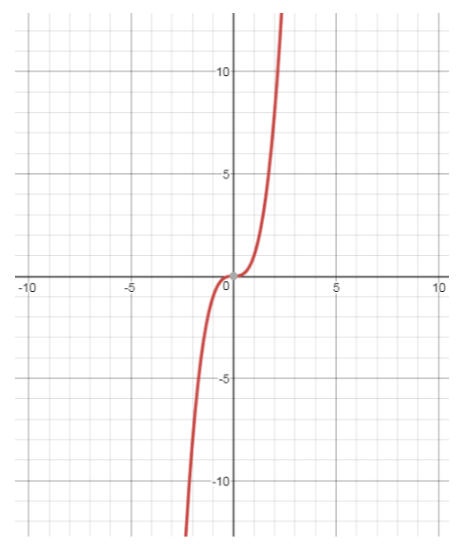
Show that the function \[f:R \to R\]given by \[f(x) = {x^3}\;\]is injective
Answer
515.1k+ views
Hint: since we know the graph of the function hence we will draw the
graph of this function and then solve

Now from the graph we can solve the question easily
Since we know that
A function is a one-to-one function if and only if each second element corresponds to one and only one first element. (each $x$ and $y$ value is used only once)
Now we use the horizontal line test to determine whether the function is one to one or not
The horizontal line test is
If ANY horizontal line intersects your original function in ONLY ONE location, your function will be a one-to-one function and its inverse will also be a function.
Now if we draw a horizontal line in this graph it will intersect the graph only at once place hence it is one-to-one function
Which could also be proved as
Let assume that \[x,y \in R\;\]such that
\[
f(x) = f(y) \\
\Rightarrow {x^3} = {y^3} \\
\Rightarrow x = y \\
\]
Hence we again prove that the function is one to one function
Now a function is injective if it is a ONE-TO-ONE
Hence we have that this function is ONE-TO-ONE hence this function is an injective function.
Note: While testing any function for injective function or one-to-one function or bijective function or any other we should draw their graph if we know them and then solve them then it is easy.
.
graph of this function and then solve

Now from the graph we can solve the question easily
Since we know that
A function is a one-to-one function if and only if each second element corresponds to one and only one first element. (each $x$ and $y$ value is used only once)
Now we use the horizontal line test to determine whether the function is one to one or not
The horizontal line test is
If ANY horizontal line intersects your original function in ONLY ONE location, your function will be a one-to-one function and its inverse will also be a function.
Now if we draw a horizontal line in this graph it will intersect the graph only at once place hence it is one-to-one function
Which could also be proved as
Let assume that \[x,y \in R\;\]such that
\[
f(x) = f(y) \\
\Rightarrow {x^3} = {y^3} \\
\Rightarrow x = y \\
\]
Hence we again prove that the function is one to one function
Now a function is injective if it is a ONE-TO-ONE
Hence we have that this function is ONE-TO-ONE hence this function is an injective function.
Note: While testing any function for injective function or one-to-one function or bijective function or any other we should draw their graph if we know them and then solve them then it is easy.
.
Recently Updated Pages
Master Class 12 Economics: Engaging Questions & Answers for Success

Master Class 12 Maths: Engaging Questions & Answers for Success

Master Class 12 Biology: Engaging Questions & Answers for Success

Master Class 12 Physics: Engaging Questions & Answers for Success

Master Class 12 Business Studies: Engaging Questions & Answers for Success

Master Class 12 English: Engaging Questions & Answers for Success

Trending doubts
Which are the Top 10 Largest Countries of the World?

Differentiate between homogeneous and heterogeneous class 12 chemistry CBSE

Draw a labelled sketch of the human eye class 12 physics CBSE

What is the Full Form of PVC, PET, HDPE, LDPE, PP and PS ?

What is a transformer Explain the principle construction class 12 physics CBSE

What are the major means of transport Explain each class 12 social science CBSE




